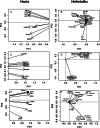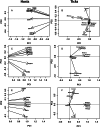Ecto- and endoparasites of common reedbuck, Redunca arundinum, at 2 localities in KwaZulu-Natal Province, South Africa: community and network structure
- PMID: 38801059
- PMCID: PMC11474021
- DOI: 10.1017/S0031182024000532
Ecto- and endoparasites of common reedbuck, Redunca arundinum, at 2 localities in KwaZulu-Natal Province, South Africa: community and network structure
Abstract
Parasite community structure is governed by functional traits of hosts and parasites. Notably, parasite populations and communities respond to host social and spatial behaviour. Many studies demonstrating these effects dealt with small-bodied host species, while the influence of host social patterns on parasite communities in large hosts remains understudied. In an earlier study on nyalas (Tragelaphus angasii), host age was more important than sex in structuring helminth communities and networks, but the influence of both was mediated by local environmental conditions, creating different locality patterns. Common reedbuck (Redunca arundinum) differ from nyalas in spatial and social behaviour. Based on helminth and ectoparasite data from 56 reedbuck examined at 2 localities in KwaZulu-Natal Province, we asked which patterns are similar and which differ between the 2 host species. Similar to nyalas, reedbuck age was more important than sex in structuring communities and networks. However, local environmental conditions exerted the strongest influence on transmission patterns, especially in ectoparasites. Complex interactions between reedbuck traits, parasite traits and local environmental conditions modulated the risk of infection differently at the 2 sites, confirming our earlier findings in nyalas that pooling data from different locations may obscure location-specific parasite community patterns. Similarities between patterns in reedbuck and nyalas, despite their behavioural differences, suggest some common patterns in parasite community ecology that, in turn, are determined mostly by parasite traits and population dynamics.
Keywords: helminths; host–parasite interactions; infracommunities; lice; nestedness; ticks.
Conflict of interest statement
None.
Figures








Similar articles
-
Impact of host sex and age on the diversity of endoparasites and structure of individual-based host-parasite networks in nyalas (Tragelaphus angasii Angas) from three game reserves in KwaZulu-Natal province, South Africa.Parasitol Res. 2022 Nov;121(11):3249-3267. doi: 10.1007/s00436-022-07653-x. Epub 2022 Sep 8. Parasitol Res. 2022. PMID: 36071296
-
Arthropod parasites of common reedbuck, Redunca arundinum, in Natal.Onderstepoort J Vet Res. 1988 Mar;55(1):19-22. Onderstepoort J Vet Res. 1988. PMID: 3353095
-
Parasites of South African wildlife. III. Helminths of common reedbuck, Redunca arundinum, in Natal.Onderstepoort J Vet Res. 1989 Mar;56(1):51-7. Onderstepoort J Vet Res. 1989. PMID: 2726193
-
The ecology of fish parasites with particular reference to helminth parasites and their salmonid fish hosts in Welsh rivers: a review of some of the central questions.Adv Parasitol. 2002;52:1-154. doi: 10.1016/s0065-308x(02)52011-x. Adv Parasitol. 2002. PMID: 12521260 Review.
-
Arthropod parasites of some wild animals in South Africa and Namibia.J S Afr Vet Assoc. 1987 Dec;58(4):207-11. J S Afr Vet Assoc. 1987. PMID: 3334142 Review.
References
-
- Almeida-Neto M, Guimaraes P, Guimaraes PR Jr, Loyola RD and Ulrich W (2008) A consistent metric for nestedness analysis in ecological systems: reconciling concept and measurement. Oikos 117, 1227–1239.
-
- Altizer S, Nunn CL, Thrall PH, Gittleman JL, Antonovics J, Cunningham AA, Dobson AP, Ezenwa V, Jones KE, Pedersen AB and Poss M (2003) Social organization and parasite risk in mammals: integrating theory and empirical studies. Annual Review of Ecology, Evolution, and Systematics 34, 517–547.
-
- Anderson RC (2000) Nematode Parasites of Vertebrates. Their Development and Transmission, 2nd Edn. Wallingford, UK: CABI Publishing.
-
- Arneberg P (2002) Host population density and body mass as determinants of species richness in parasite communities: comparative analyses of directly transmitted nematodes of mammals. Ecography 25, 88–94.
MeSH terms
LinkOut - more resources
Full Text Sources

